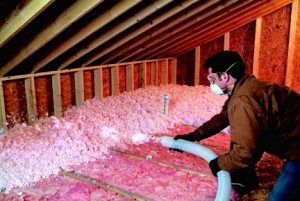One of the biggest challenges in winter is maintaining a comfortable climate inside the home. While this hinges upon having a properly functioning furnace, another critical aspect is your home’s ability to conserve the heat it generates. Heat is an expert escape artist, so the more escape routes your home contains, the harder your furnace will need to work to replenish that lost heat (and the more money you’ll spend as a result). To help you minimize heat loss in your home, we’ve asked seven Diamond Certified Experts to pinpoint some areas that should be addressed.
Windows
Not surprisingly, windows are a favorite escape route for furnace-generated heat. Even if your home has double-pane windows, Kevin Gundry of Custom Exteriors, Inc. explains how upgrading to a modern window product can substantially increase your home’s thermal efficiency. “Double-pane windows have come a long way over the last decade, with today’s products incorporating several performance-enhancing innovations. One such innovation is low-E 366 glass, which contains layers of silver oxide that reflect radiant heat and filter out UV light, making the glass far more thermally efficient than conventional glass. Today’s double-pane windows also feature nonconductive spacers that don’t conduct heat and cold like their metal precursors. There’s also argon, a colorless, odorless gas that further improves window insulation and performance when inserted between the panes.”
According to Jeff Alexander of Alexander Company, a window’s frame can also have an impact on its insulation value, which is why it’s worthwhile to consider replacing frames that are outdated or inefficient. For mid-priced homes, a good replacement choice is vinyl window frames, which provide ample insulation and long-term performance for an affordable price.
Attic

By keeping conditioned air from escaping the living area below, attic air sealing significantly reduces energy loss. Photo: Alcal Specialty Contracting, Inc. ©2021
Everyone knows heat rises, so it should come as no surprise that another common escape route is gaps between the living space and the attic. To prevent this, Greg Sutliff of Alcal Specialty Contracting, Inc. recommends having your attic professionally sealed and reinforced with insulation. By sealing joints where the wall meets the ceiling (as well as gaps where electrical wires, water lines, vents and mechanical equipment enter the attic), you can reduce your HVAC system’s workload, saving energy and money in the process.
Air ducts
If heat loss through leaky windows and attics requires a furnace to work harder, you can imagine the impact that leaky air ducts can have, as they’re responsible for delivering that heated air throughout the home. That’s why Mike Rebholtz of Alternative Heating & Air Conditioning Solutions, Inc. says repairing leaky air ducts can decrease your energy bills by as much as 30 percent. So, if you can’t remember the last time your ductwork was looked at, have an HVAC professional conduct an inspection to assess its condition.
Doors
Gaps between a door and its frame are a common source of home energy loss. While weather stripping and sweeps can help alleviate this issue, David Lopez of Custom Exteriors, Inc. says a surefire solution is to upgrade to fiberglass exterior doors. “Since fiberglass doors aren’t made of wood, they don’t expand and contract with changes in weather, which avoids issues like sticking or air gaps. Plus, because it has a foam core, a fiberglass door is denser and more energy-efficient than a conventional wood door.” Mr. Lopez also points out that fiberglass doors are extremely strong, are available in a wide variety of colors and styles, and add to a home’s resale value.
General air gaps
Even if you have quality windows and a well-insulated attic, Blaine Munsch of Willow Creek Construction says there are several less conspicuous areas through which heat can escape. Some of these include uninsulated light switches, circuit plugs and baseboards, as well as gaps around and beneath exterior doors. Added together, these breaches can represent a substantial drain on your home’s energy efficiency. Fortunately, most of them can be easily eliminated with products like caulking, expansive foam and weather stripping. Prior to winter, inspect your home for sources of air transmission and employ an appropriate insulating application where needed.
According to Richard Hiteshew of A-1 Guaranteed Heating & Air, Inc., a good way to identify these smaller sources of air loss is with a blower door test. “A blower door test is usually conducted as part of a general home energy audit,” he explains. “A blower door is a powerful fan that’s mounted into the frame of an exterior door. Once all the other exterior doors and windows are shut, the blower door is turned on. As the blower door pulls air out of the house, the interior air pressure is lowered, which causes higher exterior air pressure to flow in through all unsealed cracks and openings. This allows the home energy auditor to identify sources of energy loss.”
